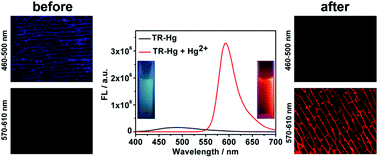An ultra-sensitive and ratiometric fluorescent probe based on the DTBET process for Hg2+ detection and imaging applications†
Abstract
In this article, we present an ultra-sensitive and ratiometric fluorescent probe (TR-Hg) for Hg2+ detection based on the mechanism of aggregation induced emission (AIE) and dark through-bond energy transfer (DTBET). The probe was constructed using tetraphenylethene as the dark donor and rhodamine B thiolactone as the acceptor. By exploiting the advantages of DTBET, which eliminates emission leakage from dark donors and provides nearly 100% energy transfer efficiency, TR-Hg exhibits more than a 30 000-fold fluorescence ratio enhancement after reacting with Hg2+. TR-Hg demostrates (i) a detection limit of 43 pM, which is the lowest among the reported ratiometric Hg2+ probes, (ii) excellent selectivity, fast response-time (<10 s) and a wide pH application range, (iii) strong applicability for paper-based colorimetric assay, where readout can be performed by the naked eye, and (iv) fluorescent imaging of Hg2+ in onion epidermal tissues, indicating its potential use in living organisms.



 Please wait while we load your content...
Please wait while we load your content...